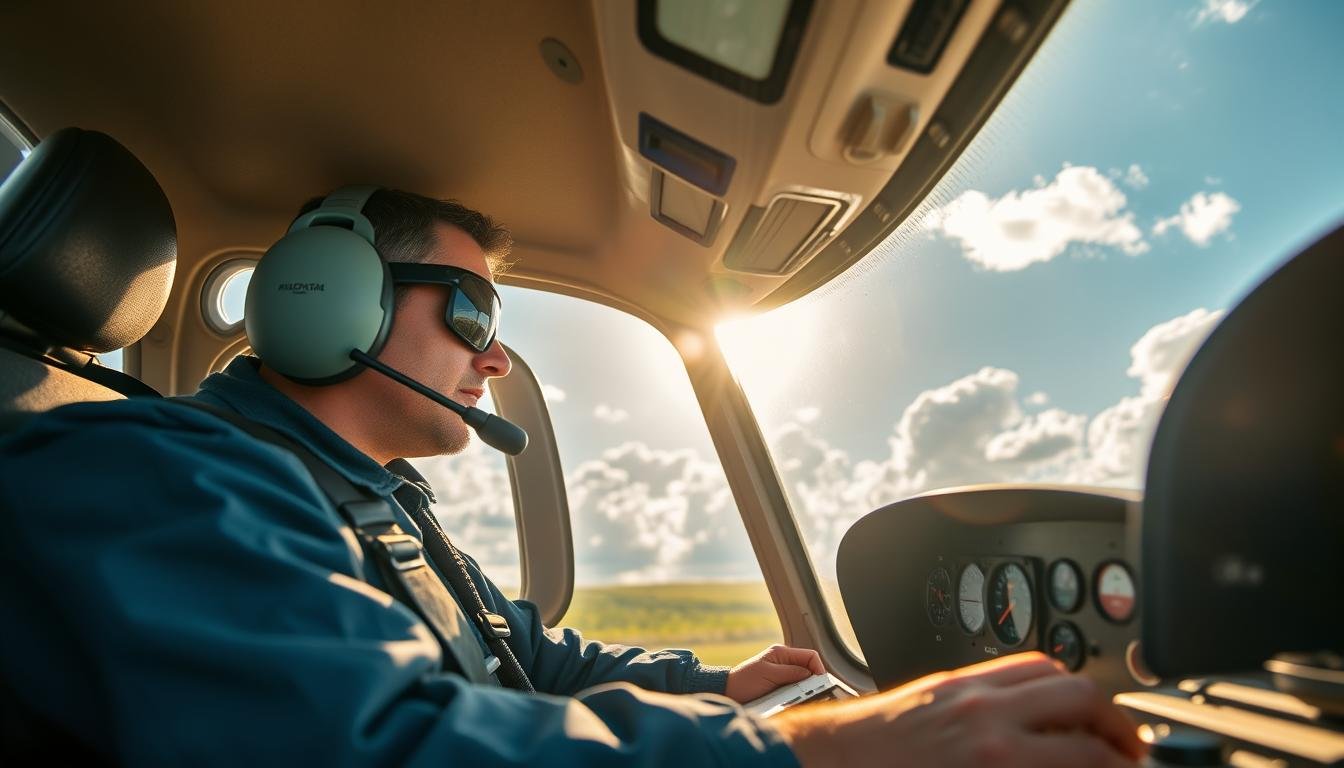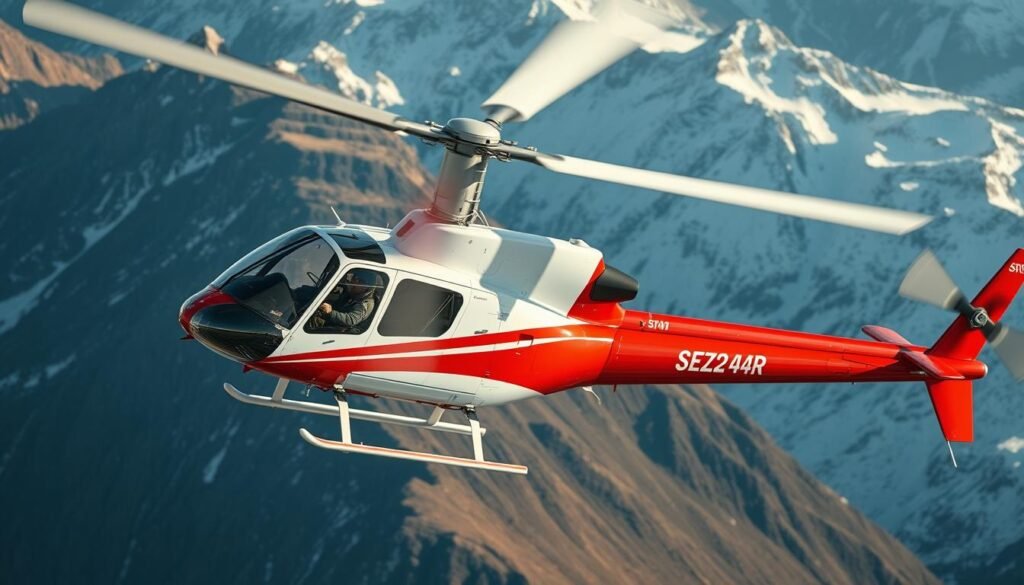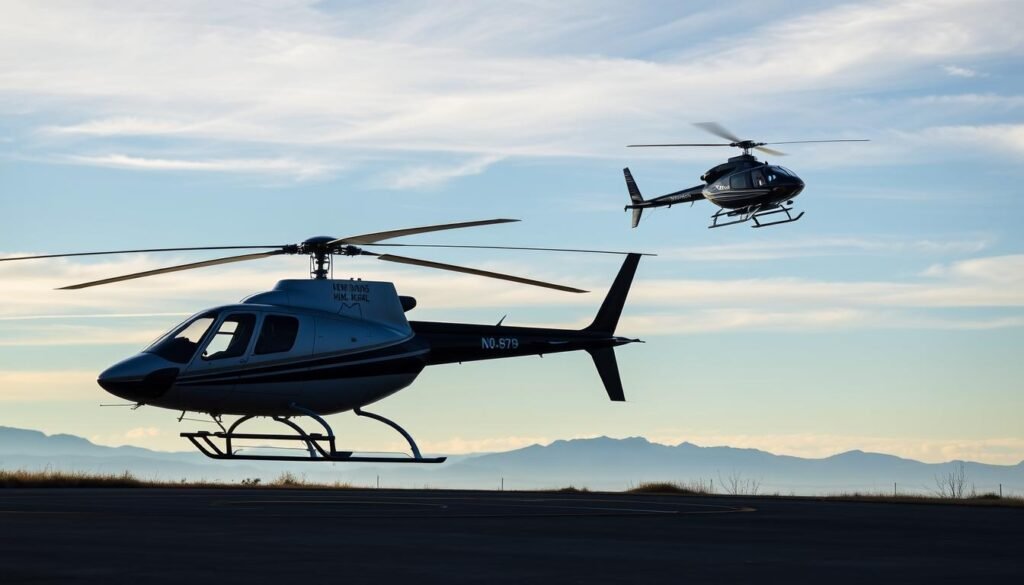Surprising fact: most U.S. helicopter pilot lessons programs report students averaging 55–60 hours to earn a private certificate, well above the FAA’s 40‑hour minimum.
The journey begins with a discovery flight that combines a ground briefing and a short flight with a certified instructor. This first step covers cockpit gauges, preflight checks, and basic maneuvers to build core skills and confidence.
Many schools favor the Robinson R22 and R44 for initial training because these models offer reliable handling for new learners. Students then follow a structured program that moves from private pilot training to instrument and commercial stages, plus instructor ratings for those aiming to build hours and a career.
Clear instruction and step-by-step flight training help a student learn fly efficiently while meeting FAA Part 61 or Part 141 standards. Learners see what to expect in time commitment, required hours, and the practical path to professional roles.
Key Takeaways
- Discovery flights pair a ground briefing with hands-on flight time to introduce core concepts.
- Robinson R22/R44 are common training aircraft for reliable helicopter flight training.
- FAA paths start with a private certificate and extend through instrument and instructor ratings.
- Program tracks under Part 61 or Part 141 shape instruction, testing, and checkrides.
- Building hours and skills opens careers in tours, offshore support, and EMS roles.
- For a practical overview, see an introductory guide on learning to fly and transitioning from fixed-wing training.
Useful resources: learning to fly overview and tips on transitioning aircraft types at transitioning from fixed-wing.
Helicopter Pilot Lessons
Training begins with a paired ground briefing and an introductory flight that orients new learners. Instructors personalize each session so a student can learn fly efficiently and safely from day one.
Start Your Helicopter Flight Training Journey With Certified Instructors
Certified flight instructors review gauges, controls, and the preflight checklist during a 30-minute ground lesson. They set clear objectives and sign off each milestone in the student logbook.
Train In Robinson R22 And R44 Helicopters For Proven Learning
Robinson R22 and R44 models offer predictable handling and cost-effective hours. Many schools use these helicopters because they minimize downtime and let students build practical skills fast.
Discovery And Introductory Flights: What To Expect On The Ground And In Flight
After the briefing, the flight instructor demonstrates pedals, cyclic, and collective. Students then see straight-and-level, turns, climbs, descents, and a first hover under direct supervision.
Sample Discovery Flight Options, Time, And Pricing
Typical discovery packages pair 30 minutes ground with 30 minutes flight or a one-hour flight. Sample pricing: R22 — $199 (30/30) or $375 (30/60); R44 — $299 (30/30) or $575 (30/60). Logbook upgrades run about $9.95.
FAA-Approved School Standards Under Part 141 And Part 61
Schools operating under FAR Part 141 or Part 61 use structured syllabi and documented instruction. Helipro in San Luis Obispo, CA, is one example known for experienced instructors and high maintenance standards.
Building Foundational Knowledge, Skills, And Confidence As A Student Pilot
Each flight and ground session builds measurable skills that lead into private pilot, instrument, and advanced ratings. Prospective students can also review costs and pathways such as the cost to become an EMS helicopter for career planning.
Flight Training Pathways And FAA Requirements
Structured pathways guide a learner from basic rotorcraft skills to instrument and commercial credentials with measurable milestones.
Private Pilot Rotorcraft: Eligibility, Hours, Ground Instruction, And Checkride
The private pilot path lists a federal minimum of 40 hours total time, though most students average 55–60 hours. Typical syllabi include 20 hours dual, 10 hours solo, and ground instruction with a CFI or approved home study.
Students must pass the FAA knowledge exam and complete a practical test and oral with a DPE to receive the certificate.
Instrument Rating: Simulated Or Actual Instrument Time, Cross-Country, And Approaches
An instrument rating requires holding a private certificate first and meeting cross-country and instrument-hour thresholds. Candidates log 50 hours cross-country PIC (10 in helicopters) and 40 hours of actual or simulated instrument time, with 15 in helicopters.
Training covers instrument control, navigation, and approaches down to landing minima.
Commercial Pilot: Total Time, PIC, Helicopter Hours, Day And Night VFR, And Exams
The commercial track requires 150 total hours, with 100 in powered aircraft and at least 50 in helicopters. It specifies PIC time, cross-country, day and night VFR, instrument training, solo flights, and passing knowledge and practical exams.
Certified Flight Instructor And CFII: Fundamentals Of Instruction And Left-Seat Teaching
CFI/CFII training focuses on the Fundamentals of Instruction, lesson planning, classroom delivery, and left-seat maneuver teaching. Most candidates log 10–15 hours per rating before the checkride, including full-down autorotations.
Professional Pilot Program: From Zero Time To Career-Ready Pilot
Professional programs bundle these steps into a single curriculum to move zero-time students toward commercial readiness and early employment opportunities.
PPL Helicopter Add-On For Rated Airplane Pilots
An add-on path lets airplane-rated flyers convert skills efficiently by meeting helicopter-specific hours and certificate requirements for the rotorcraft privilege.

For a complete program overview and certification timelines, see training programs and certifications.
Training Experience, Locations, And Student Opportunities
Training locations with varied terrain and steady weather speed skill acquisition and make each flight more instructive.
Lancaster, Pennsylvania And San Luis Obispo, California: Scenic, Accessible Training Environments
Lancaster offers discovery flights and full courses using Robinson models. The program balances detailed ground briefings with structured flight time.
San Luis Obispo (Helipro) is FAA-approved under Parts 141 and 61. It is known for well‑maintained aircraft, steady weather, and wide training areas.

Student Experience Highlights And Instructor Quality
Experienced instructors focus on patient instruction and clear debriefs after each flight. Graduates like Mitchel Joiner and Kelton Porter praise confidence building and high standards.
Certified flight instructor teams reinforce knowledge through repetition and scenario‑based flight. Ground lessons and flight blocks are designed to deliver measurable skill gains.
Career Pathways: Time Building To 1000 Hours, Tours, Gulf Operations, And EMS
Most students build toward ~1,000 hours by teaching as a CFI/CFII. That time often leads to roles in tours (Grand Canyon, Alaska), Gulf support, and EMS.
Programs combine private pilot work, instrument training, and structured CFI time to create a predictable path to commercial opportunities.
| Location | Key Advantages | Career Outcomes |
|---|---|---|
| Lancaster, PA | Accessible airports, Robinson fleet, detailed ground-to-flight syllabi | Private certificates, steady hour building, local tour roles |
| San Luis Obispo, CA | FAA Part 141/61 programs, maintained aircraft, consistent weather | High-quality instruction, CFI roles, Gulf and EMS pipelines |
| Program Features | Certified flight instructor staff, scenario training, repeatable syllabus | Faster, reliable hour accumulation; prepared for checkrides and jobs |
Prospective students can explore local school details and schedules at flight training pages or review top academies for program comparisons at top academies.
Conclusion
A compact ground briefing paired with a trial flight offers a fast way to meet an instructor and confirm goals before enrolling in a program.
Consistent training, clear ground objectives, and targeted practice shorten the time to each checkride. Dependable helicopters and experienced flight instructor staff help track hours and progress transparently.
Instrument proficiency and staged milestones build capability for private, instrument, and commercial paths that lead toward ~1,000 hours and early job options like EMS or tours.
Contact a local school to book a discovery flight, review schedules and financing, and start a personalized training plan that fits availability and career aims.
FAQ
How can a beginner start learning to fly a rotorcraft?
A beginner should begin with a discovery flight and an assessment with a certified flight instructor. The instructor reviews basic aerodynamics, safety gear, and controls on the ground, then conducts a short dual flight so the student experiences hovering, basic turns, and communications. After that, enrolling in a Part 61 or Part 141 program sets a clear training plan with required flight and ground hours toward a private certificate.
What aircraft are commonly used for initial training and why?
Common trainers include the Robinson R22 and R44 because they offer predictable handling, wide availability, and lower operating costs. Schools use these models to teach fundamentals like start-up procedures, collective and cyclic control, hover work, and autorotation practice before transitioning students to larger or turbine aircraft for advanced instruction.
What happens during a discovery or introductory flight?
During a discovery flight, the student receives a brief ground orientation covering controls, safety briefings, and cockpit layout. The dual flight includes basic maneuvers such as takeoff, climb, hover, and landing under instructor supervision. The goal is to give realistic hands-on exposure so the student can decide whether to commit to formal training.
How long is a typical discovery flight and what does it cost?
Discovery flights usually last 30 to 60 minutes of dual time. Pricing varies by school and location but often ranges from a modest introductory fee to a higher rate for longer flights or scenic options. Many schools offer package deals that apply the discovery cost toward future training hours.
What are the differences between Part 61 and Part 141 schools?
Part 61 schools provide flexible training tailored to the student’s schedule and pace. Part 141 programs follow an FAA-approved syllabus with structured lesson plans and syllabus-based stage checks. Part 141 can be more efficient for students seeking accelerated paths and may have stricter recordkeeping and instructor standards.
What foundational knowledge and skills will a student develop first?
Early training focuses on flight controls, hover control, basic maneuvers, emergency procedures like autorotation, radio communications, and preflight checks. Ground instruction covers aerodynamics, weather, regulations, and human factors. These basics build confidence and safe decision-making for solo flights.
What are the eligibility requirements and flight hour minimums for a private rotorcraft certificate?
Eligibility requires being at least 17 years old, meeting medical standards, and completing required ground instruction. Minimum flight time under FAA rules is 40 hours for Part 61 private rotorcraft, including specified dual and solo hours; many students require additional time to meet proficiency for the checkride.
How does instrument training work for rotorcraft?
Instrument training combines simulated or actual IMC flight time, cross-country navigation, and instrument approaches. Students work toward an instrument rating by learning procedures in the cockpit, using avionics and gyroscopic instruments, and building competency in partial-visibility flying to improve safety and expand mission capability.
What are the requirements for a commercial rotorcraft certificate?
A commercial certificate requires meeting higher flight time totals, including specific PIC, cross-country, and night experience. The applicant must demonstrate advanced maneuvers, performance planning, and knowledge on FAA written and practical exams. Night vision and instrument proficiency often factor into career readiness.
What does training to become a Certified Flight Instructor (CFI) or CFII involve?
CFI training teaches instructional techniques, risk management, and how to evaluate student performance. The CFII adds instrument instruction skills. Candidates practice lesson planning, in-flight teaching, and mock oral exams before FAA practical tests to earn instructor certificates and logbook endorsements.
How does a professional pilot program take someone from zero time to career-ready?
A professional program sequences private, instrument, and commercial training with structured time building and CFI phases. It includes classroom ground school, simulator sessions, and real-world flight experience targeting total hours for entry-level commercial roles. Many programs also emphasize resume building and job placement support.
Can a rated airplane pilot add a rotorcraft certificate, and what does that process look like?
An airplane-rated pilot can add a rotorcraft category by completing transition training that covers helicopter aerodynamics, controls, and maneuvers. The training includes dual instruction, required practice areas, and a practical test tailored to differences in handling and emergency procedures unique to rotary-wing aircraft.
Where are popular training locations and why choose them?
Locations like Lancaster, Pennsylvania and San Luis Obispo, California offer diverse airspace, reliable weather, and scenic training environments. Students pick sites based on climate, local air traffic complexity, and proximity to employers or career opportunities such as tours, EMS, or offshore operations.
What should students expect about instructor quality and the overall training experience?
High-quality schools employ experienced, certified flight instructors who prioritize safety, clear communication, and individualized progression. Students can expect a mix of ground school, hands-on dual flights, and solo time. Good programs track progress, provide regular feedback, and offer mentorship for career planning.
What career pathways are available after initial certification and how does time building work?
Career paths include aerial tours, news and media work, EMS, utility operations, and offshore transport. New pilots typically time-build to 1,000 hours through instructing, aerial surveying, or turbine transitions. Employers seek consistent hours, instrument experience, and specialized training for certain missions.
Additional Resources
- How to Choose the Leading Helicopter Academy for Your Aviation Career
- What You Need to Know Before Flying a Helicopter for the First Time
Buying helicopter lessons is an investment in a thrilling and rewarding skill. By understanding your goals, researching schools, and prioritizing safety, you can embark on your aviation journey with confidence. Whether for career ambitions or personal enjoyment, the experience of flying a helicopter is unmatched in its excitement and fulfillment. Take the leap and soar into the skies today!



